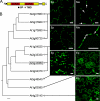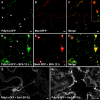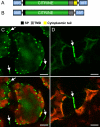Specific targeting of a plasmodesmal protein affecting cell-to-cell communication
- PMID: 18215111
- PMCID: PMC2211546
- DOI: 10.1371/journal.pbio.0060007
Specific targeting of a plasmodesmal protein affecting cell-to-cell communication
Abstract
Plasmodesmata provide the cytoplasmic conduits for cell-to-cell communication throughout plant tissues and participate in a diverse set of non-cell-autonomous functions. Despite their central role in growth and development and defence, resolving their modus operandi remains a major challenge in plant biology. Features of protein sequences and/or structure that determine protein targeting to plasmodesmata were previously unknown. We identify here a novel family of plasmodesmata-located proteins (called PDLP1) whose members have the features of type I membrane receptor-like proteins. We focus our studies on the first identified type member (namely At5g43980, or PDLP1a) and show that, following its altered expression, it is effective in modulating cell-to-cell trafficking. PDLP1a is targeted to plasmodesmata via the secretory pathway in a Brefeldin A-sensitive and COPII-dependent manner, and resides at plasmodesmata with its C-terminus in the cytoplasmic domain and its N-terminus in the apoplast. Using a deletion analysis, we show that the single transmembrane domain (TMD) of PDLP1a contains all the information necessary for intracellular targeting of this type I membrane protein to plasmodesmata, such that the TMD can be used to target heterologous proteins to this location. These studies identify a new family of plasmodesmal proteins that affect cell-to-cell communication. They exhibit a mode of intracellular trafficking and targeting novel for plant biology and provide technological opportunities for targeting different proteins to plasmodesmata to aid in plasmodesmal characterisation.
Conflict of interest statement
Figures








References
-
- Kurata T, Okada K, Wada T. Intercellular movement of transcription factors. Curr Opin Plant Biol. 2005;8:600–605. - PubMed
-
- Dunoyer P, Himber C, Voinnet O. DICER-LIKE 4 is required for RNA interference and produces the 21-nucleotide small interfering RNA component of the plant cell-to-cell silencing signal. Nat Genet. 2005;37:1356–1360. - PubMed
-
- Lucas WJ. Plant viral movement proteins: agents for cell-to-cell trafficking of viral genomes. Virology. 2006;344:169–184. - PubMed
Publication types
MeSH terms
Substances
LinkOut - more resources
Full Text Sources
Other Literature Sources
Molecular Biology Databases

